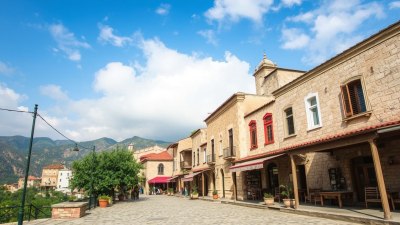Where Dust Settles Like History in Gjirokastër, Albania
Explore the rich history and stunning architecture of Gjirokastër, Albania, a UNESCO World Heritage Site.

Image created with Flux Schnell
Gjirokastër, a picturesque city located in the southern region of Albania, is a UNESCO World Heritage Site renowned for its beautiful stone architecture and rich historical significance. Often called the 'City of Stone', Gjirokastër offers visitors a unique glimpse into the past with its well-preserved Ottoman-era buildings, cobbled streets, and vibrant cultural life. The town has a distinctive beauty that enchants every traveler, inviting them to wander through its narrow alleys and immerse themselves in its rich history.
One of the most striking aspects of Gjirokastër’s architecture is its unique stone houses, many of which are several centuries old. These impressive structures, built from local grey stone, are characterized by their slate roofs and tall, narrow windows, which give the city an enchanting skyline. As you ascend the hill towards the old castle, you can see the houses cascading down the slopes, creating a beautiful patchwork of natural and man-made beauty. The Old Bazaar, a lively area adorned with artisan shops and traditional eateries, is a fantastic place to start exploring Gjirokastër.
The Gjirokastër Castle, perched atop a hill, dominates the skyline and provides breathtaking views of the surrounding landscapes, including the Drino River valley. This fortress dates back to the 12th century and has witnessed numerous historical events throughout the centuries, serving as a military stronghold and a royal palace. Within the castle walls, visitors can explore various museums that showcase the region's history, culture, and traditions. The castle also features a fascinating collection of weaponry and artifacts from different historical periods, illuminating the rich past of Gjirokastër.
Exploring the Rich Cultural Heritage
The cultural heritage of Gjirokastër is vast and intriguing. The town was once the birthplace of several notable figures, including Nobel Prize-winning author Ismail Kadare. As a result, Gjirokastër is often associated with literary and artistic heritage, making it an ideal destination for culture enthusiasts. Visitors can find numerous memorials and tributes throughout the city that honor its famous sons and daughters, celebrating their contributions to literature and art.
Gjirokastër also hosts various cultural events and festivals throughout the year, which highlight the traditional craftsmanship and music of the region. The Festival of Folk Songs and Dances is a particularly vibrant celebration that showcases traditional Albanian folklore, music, and dance. Attendees can enjoy performances from local artists and even take part in workshops to learn traditional crafts, such as weaving, pottery, and woodwork.
Gastronomy and Culinary Delights
No exploration of Gjirokastër would be complete without indulging in the local cuisine. Albanian food reflects the country’s rich cultural influences, as it has been shaped by Mediterranean, Balkan, and Ottoman traditions. In Gjirokastër, visitors can sample traditional dishes such as 'qifqi', rice balls flavored with mint, or 'tave kosi', a delicious baked dish made with lamb and yogurt.
The city is also famous for its local rakia, a potent fruit brandy often made from grapes or plums. This traditional beverage is a staple at many meals and social gatherings, offering a true taste of Albanian hospitality. Many restaurants in Gjirokastër serve dishes made from fresh, locally sourced ingredients, allowing visitors to experience the unique flavors of the region.
Natural Beauty and Surroundings
Surrounding Gjirokastër is a landscape of stunning natural beauty. The Albanian Alps to the north provide a breathtaking backdrop, while the rivers and lush valleys offer countless opportunities for outdoor adventures. Hiking, mountain biking, and exploring the nearby national parks are popular activities among visitors seeking to experience the breathtaking landscapes of southern Albania.
The nearby Blue Eye, a mesmerizing natural spring, is a must-visit for nature lovers. This pool of crystal-clear water is surrounded by lush vegetation and unique geological formations, making it a perfect spot for a day trip from Gjirokastër. Those who venture further north can explore the stunning valleys and mountains of the Albanian Alps, where dramatic landscapes and quaint villages offer endless opportunities for exploration and discovery.
Preservation Efforts and Future Challenges
As tourism grows in Gjirokastër, ensuring the preservation of its unique heritage has become an increasingly important issue. Local authorities and organizations are working tirelessly to maintain the architectural integrity of the city and to protect it from the pressures of modern development. Restoration projects are underway to repair and preserve historical buildings, ensuring that future generations can experience the city’s rich history and culture.
However, challenges remain, as there is a delicate balance between fostering tourism and protecting cultural heritage. The rise of new hotels and shops in historical areas can threaten the authenticity of the city. Ongoing dialogue between stakeholders, including local communities, government officials, and international organizations, is crucial for ensuring that Gjirokastër's historical and cultural identity is preserved while still encouraging economic growth and development.
Timeless Charm of Gjirokastër
In conclusion, Gjirokastër is a hidden gem in the Balkans that encapsulates the charm of Albania’s rich history and culture. With its stunning architecture, vibrant cultural life, and breathtaking natural landscapes, Gjirokastër offers an unforgettable experience for travelers seeking to explore a unique and historically significant part of Albania. The dust of history settles comfortably in this ancient town, inviting visitors to tread lightly on its cobbled streets and immerse themselves in the stories that have shaped its identity. Whether you’re wandering the narrow alleyways of the Old Bazaar, exploring the castle, or indulging in local cuisine, Gjirokastër promises a journey into both the past and the vibrant present of Albanian culture.











